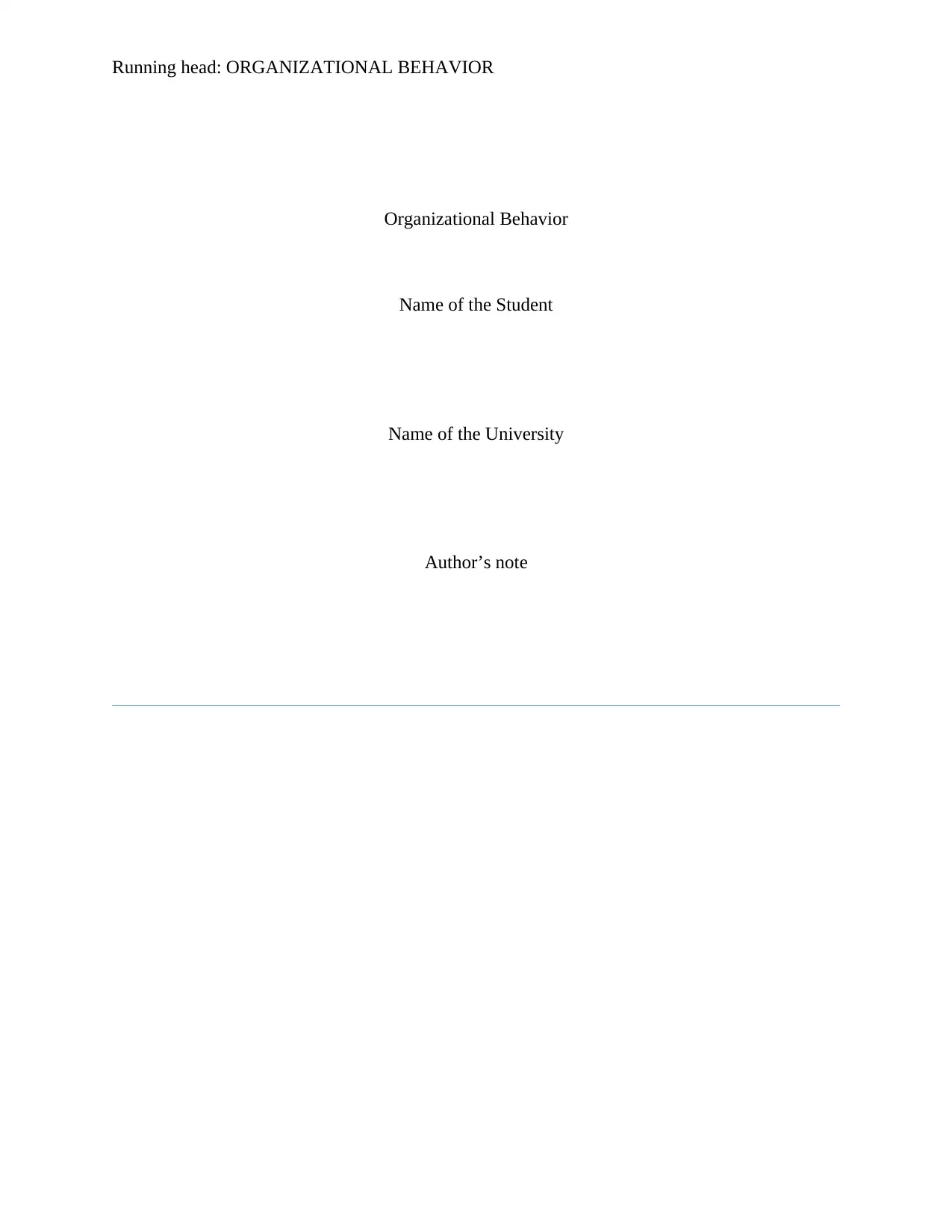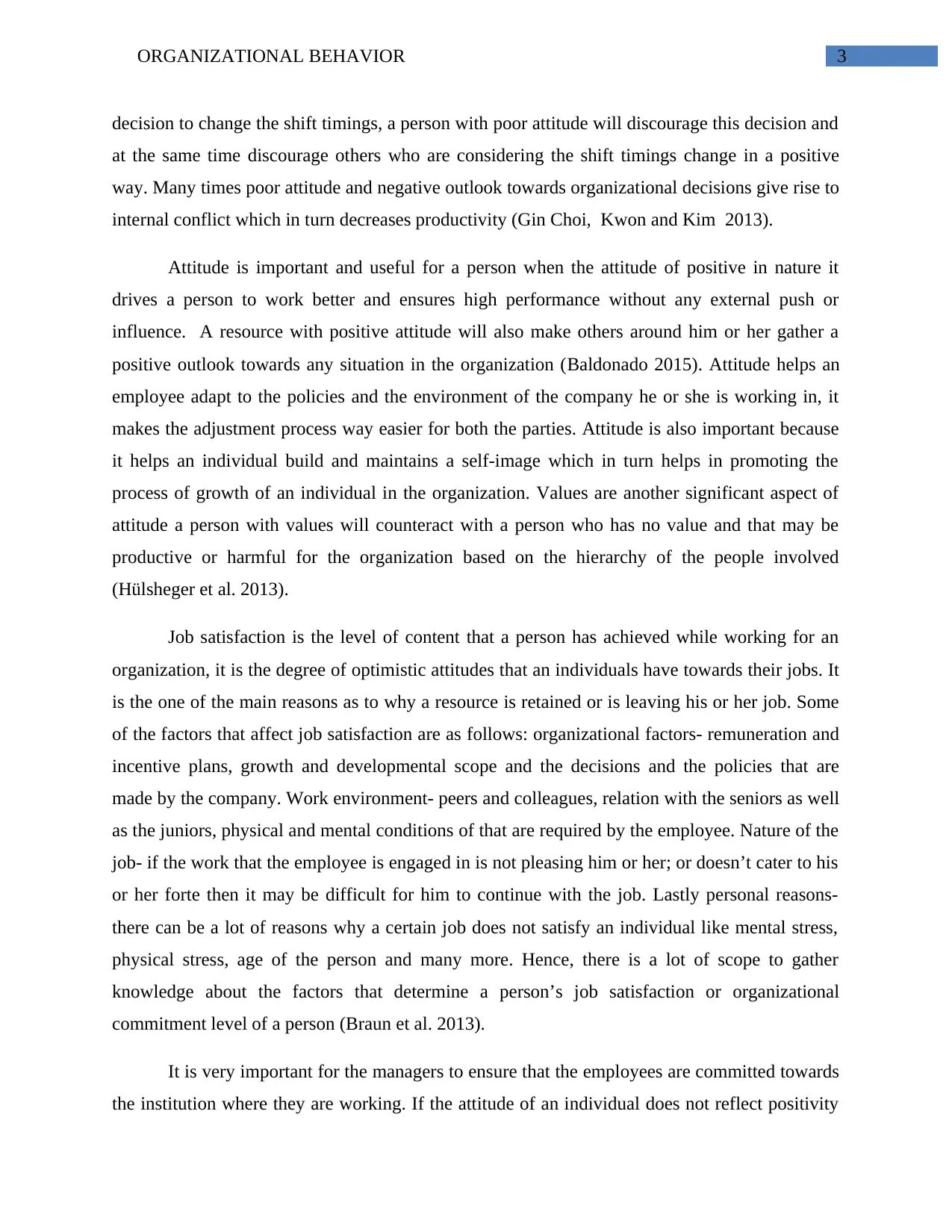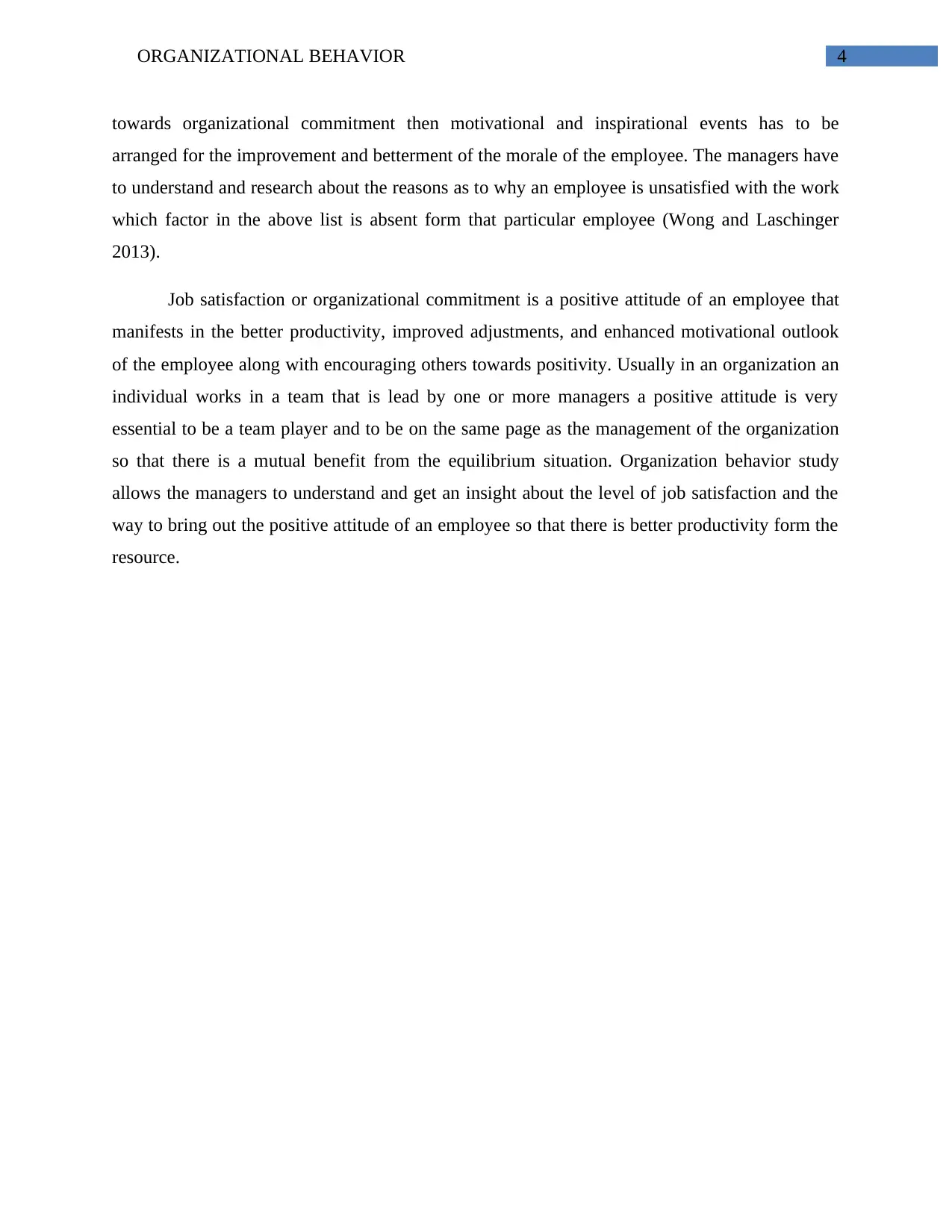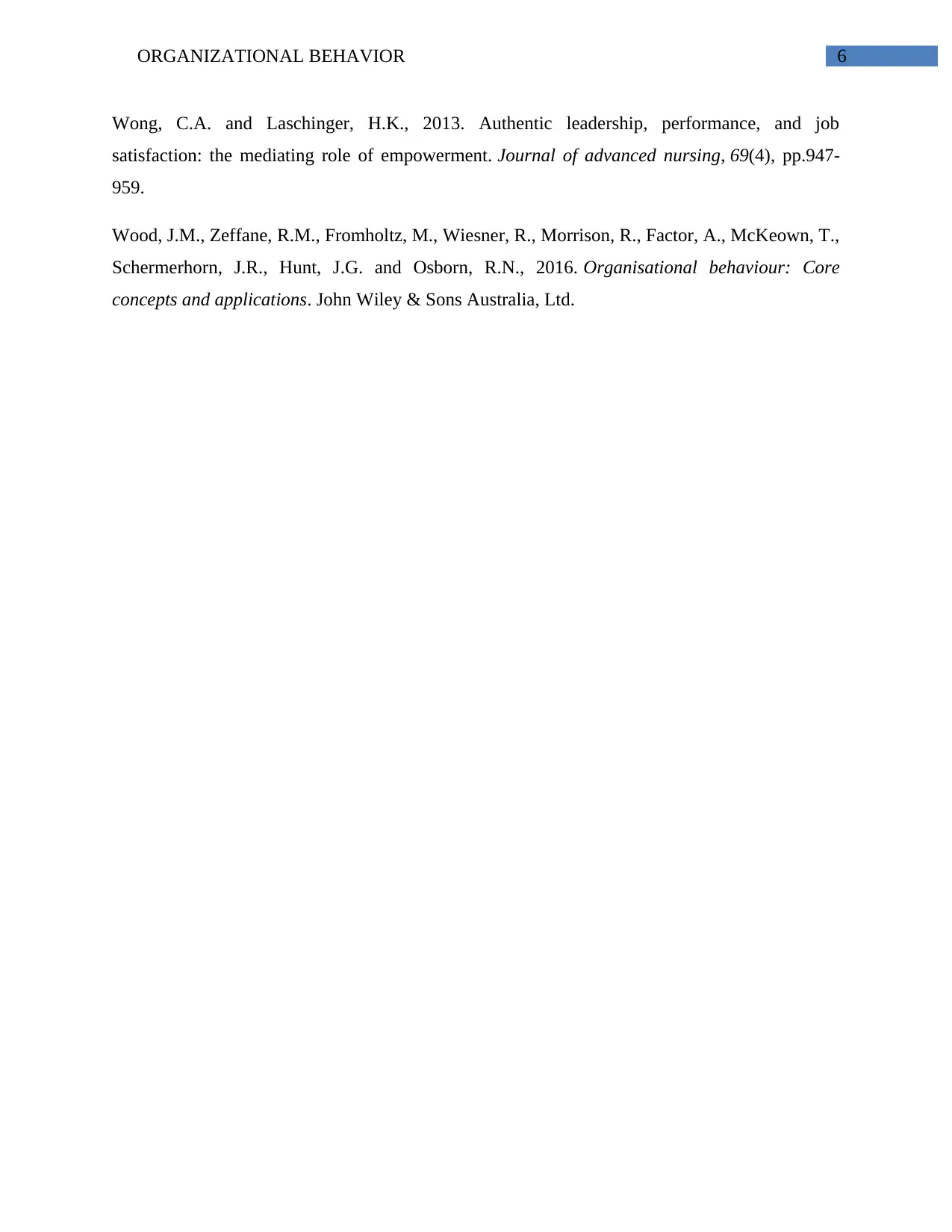Organizational Behavior: Impact on Productivity and Performance
VerifiedAdded on 2020/02/18
|7
|2119
|89
Essay
AI Summary
This essay delves into the multifaceted realm of organizational behavior, exploring its core concepts and practical applications. It begins by defining organizational behavior as the study of interactions and dynamics within groups, emphasizing its role in enhancing organizational efficiency and productivity. The essay examines key aspects such as attitude, encompassing its components (affective, behavioral, and cognitive) and formation influences, as well as its impact on workplace behavior and conflict resolution. It further investigates job satisfaction, identifying factors like remuneration, work environment, and personal reasons that contribute to employee contentment and organizational commitment. The importance of positive attitudes, values, and their role in fostering a productive and harmonious work environment are also discussed. The essay highlights how managers can leverage organizational behavior principles to understand employee attitudes, improve motivation, and promote overall organizational success, emphasizing the significance of these factors in employee retention and productivity. Finally, the essay references several academic sources to support its claims.

Running head: ORGANIZATIONAL BEHAVIOR
Organizational Behavior
Name of the Student
Name of the University
Author’s note
Organizational Behavior
Name of the Student
Name of the University
Author’s note
Paraphrase This Document
Need a fresh take? Get an instant paraphrase of this document with our AI Paraphraser

1ORGANIZATIONAL BEHAVIOR
The method of interaction, communication and mannerism among people who are in a
group can be referred to as organizational behavior. It is usually a study that is conducted to
encourage and increase the efficiency of an organization. Organizational behavior is studied to
analyze and understand and implement the tactics while managing the resources of the
organization so that there is an increase in motivation and productivity (Wood 2016). There are
several concepts in organizational behavior in human resource that is used to increase the
efficiency of the individuals in a group. Some of the topics which are studies in organizational
behavior have a direct influence on increasing productivity and performance of the resource,
improving the level of job satisfaction, promoting leadership and encouraging creativity along
with innovation. Organizational behaviors have two fold to the concept first the nature of an
individual and second the nature of an institution (Christina et al. 2014).
Various concepts are applied by the management of the organization so that the desired
result of the policies can be achieved. Some of the approaches and policies include restructuring
the members of the groups, modifying and implementing a resource friendly method of
performance evaluation and upgrading compensation policies and many more (Shafritz, Ott and
Jang 2015).
Management and the executives of an organization along with the human resource
department can take decisions and policies to make the work culture more efficient for the
employees. Organizational behavior helps the management understand the culture of the business
and paves the way to find out the facilities or hindrances in the productivity of the resources of
the origination. It also influences the hiring process of the enterprise as it helps the human
resource department to clearly state the prerequisites of the vacancy. Organizational behavior
helps the management lay down guidelines for the smooth operation on a daily basis (Pinder
2014).
Some of the importances of organizational behavior are: it provides a set of guidelines for
the management to operate. Study and analysis of organizational behavior have a major influence
on significant organizational events, it can also help to predict future events and take
precautionary measure when and if necessary. Motivation is one of the key factors in
organizational behavior theory; it helps the managers of the human resource to inspire and to
The method of interaction, communication and mannerism among people who are in a
group can be referred to as organizational behavior. It is usually a study that is conducted to
encourage and increase the efficiency of an organization. Organizational behavior is studied to
analyze and understand and implement the tactics while managing the resources of the
organization so that there is an increase in motivation and productivity (Wood 2016). There are
several concepts in organizational behavior in human resource that is used to increase the
efficiency of the individuals in a group. Some of the topics which are studies in organizational
behavior have a direct influence on increasing productivity and performance of the resource,
improving the level of job satisfaction, promoting leadership and encouraging creativity along
with innovation. Organizational behaviors have two fold to the concept first the nature of an
individual and second the nature of an institution (Christina et al. 2014).
Various concepts are applied by the management of the organization so that the desired
result of the policies can be achieved. Some of the approaches and policies include restructuring
the members of the groups, modifying and implementing a resource friendly method of
performance evaluation and upgrading compensation policies and many more (Shafritz, Ott and
Jang 2015).
Management and the executives of an organization along with the human resource
department can take decisions and policies to make the work culture more efficient for the
employees. Organizational behavior helps the management understand the culture of the business
and paves the way to find out the facilities or hindrances in the productivity of the resources of
the origination. It also influences the hiring process of the enterprise as it helps the human
resource department to clearly state the prerequisites of the vacancy. Organizational behavior
helps the management lay down guidelines for the smooth operation on a daily basis (Pinder
2014).
Some of the importances of organizational behavior are: it provides a set of guidelines for
the management to operate. Study and analysis of organizational behavior have a major influence
on significant organizational events, it can also help to predict future events and take
precautionary measure when and if necessary. Motivation is one of the key factors in
organizational behavior theory; it helps the managers of the human resource to inspire and to

2ORGANIZATIONAL BEHAVIOR
understand the challenges and grievances faced by the staff. It also helps in maintaining pleasant
relation with third parties and customers of the organization. It is very important for an
organization to develop goodwill both with the customers and the people of the industry in order
to do that (Demirtas and Akdogan 2015).
Attitude is the emotional and behavioral pattern of an individual or a group of people to
reciprocate towards any object, incident, idea or any other people or person. It is generally a
persistent propensity to behave in a certain manner. The ABC model of attitude explains that
there are three basic components of attitude: Affective, behavioral and cognitive. Affective
attitude is can be referred to as the way one is affected by a situation, circumstance, idea or any
other person. For example: Sally is scared of dogs. In this example we discuss about how dogs
affect sally. Behavioral component is the tendency if an individual to act towards an attitude. For
example: if sally is scared of dogs she will run away from it. Cognitive Component is the thought
that is associated with an attitude (Demirtas and Akdogan 2015). Formation of attitude is due to
the influences of various kinds in the lives of an individual like family and friends, colleagues at
workplace, socio economic state of the person, religious and cultural background of the person
and many more. Attitude does not predict the behavioral outcome of a person unless there are
specific circumstances like when attitude is observed on behalf of the behavior of a third person
(van Harreveld, Nohlen and Schneider 2015).
As attitude may have positive or negative influence in a situation, Commitment, content,
friendliness are some of the positive attitude of an individual at work place which reflects in the
way they behave like talking in polite manner, not loosing temper easily, enjoying work and
encouraging people around. On the other hand, boredom, irritation and discontentment leads to
negative behavior of like losing temper and screaming at people, lack of dedication and
negatively influencing people. Attitude and behavior are two different aspect of a human being.
Attitude is the inner conception and ideas he or she has about something. Behavior on the other
hand is the outer portrayal of the attitude he or she has (Biggs, Brough and Barbour 2014).
At the work place there are certain circumstances where attitude determines the behavioral
pattern of an individual like: when there is a change in some policies of the company. If a person
has a cynical attitude towards everything he or she will defiantly not be able to implement
changes in the organization in a welcoming way. For example: the management has taken a
understand the challenges and grievances faced by the staff. It also helps in maintaining pleasant
relation with third parties and customers of the organization. It is very important for an
organization to develop goodwill both with the customers and the people of the industry in order
to do that (Demirtas and Akdogan 2015).
Attitude is the emotional and behavioral pattern of an individual or a group of people to
reciprocate towards any object, incident, idea or any other people or person. It is generally a
persistent propensity to behave in a certain manner. The ABC model of attitude explains that
there are three basic components of attitude: Affective, behavioral and cognitive. Affective
attitude is can be referred to as the way one is affected by a situation, circumstance, idea or any
other person. For example: Sally is scared of dogs. In this example we discuss about how dogs
affect sally. Behavioral component is the tendency if an individual to act towards an attitude. For
example: if sally is scared of dogs she will run away from it. Cognitive Component is the thought
that is associated with an attitude (Demirtas and Akdogan 2015). Formation of attitude is due to
the influences of various kinds in the lives of an individual like family and friends, colleagues at
workplace, socio economic state of the person, religious and cultural background of the person
and many more. Attitude does not predict the behavioral outcome of a person unless there are
specific circumstances like when attitude is observed on behalf of the behavior of a third person
(van Harreveld, Nohlen and Schneider 2015).
As attitude may have positive or negative influence in a situation, Commitment, content,
friendliness are some of the positive attitude of an individual at work place which reflects in the
way they behave like talking in polite manner, not loosing temper easily, enjoying work and
encouraging people around. On the other hand, boredom, irritation and discontentment leads to
negative behavior of like losing temper and screaming at people, lack of dedication and
negatively influencing people. Attitude and behavior are two different aspect of a human being.
Attitude is the inner conception and ideas he or she has about something. Behavior on the other
hand is the outer portrayal of the attitude he or she has (Biggs, Brough and Barbour 2014).
At the work place there are certain circumstances where attitude determines the behavioral
pattern of an individual like: when there is a change in some policies of the company. If a person
has a cynical attitude towards everything he or she will defiantly not be able to implement
changes in the organization in a welcoming way. For example: the management has taken a
⊘ This is a preview!⊘
Do you want full access?
Subscribe today to unlock all pages.

Trusted by 1+ million students worldwide

3ORGANIZATIONAL BEHAVIOR
decision to change the shift timings, a person with poor attitude will discourage this decision and
at the same time discourage others who are considering the shift timings change in a positive
way. Many times poor attitude and negative outlook towards organizational decisions give rise to
internal conflict which in turn decreases productivity (Gin Choi, Kwon and Kim 2013).
Attitude is important and useful for a person when the attitude of positive in nature it
drives a person to work better and ensures high performance without any external push or
influence. A resource with positive attitude will also make others around him or her gather a
positive outlook towards any situation in the organization (Baldonado 2015). Attitude helps an
employee adapt to the policies and the environment of the company he or she is working in, it
makes the adjustment process way easier for both the parties. Attitude is also important because
it helps an individual build and maintains a self-image which in turn helps in promoting the
process of growth of an individual in the organization. Values are another significant aspect of
attitude a person with values will counteract with a person who has no value and that may be
productive or harmful for the organization based on the hierarchy of the people involved
(Hülsheger et al. 2013).
Job satisfaction is the level of content that a person has achieved while working for an
organization, it is the degree of optimistic attitudes that an individuals have towards their jobs. It
is the one of the main reasons as to why a resource is retained or is leaving his or her job. Some
of the factors that affect job satisfaction are as follows: organizational factors- remuneration and
incentive plans, growth and developmental scope and the decisions and the policies that are
made by the company. Work environment- peers and colleagues, relation with the seniors as well
as the juniors, physical and mental conditions of that are required by the employee. Nature of the
job- if the work that the employee is engaged in is not pleasing him or her; or doesn’t cater to his
or her forte then it may be difficult for him to continue with the job. Lastly personal reasons-
there can be a lot of reasons why a certain job does not satisfy an individual like mental stress,
physical stress, age of the person and many more. Hence, there is a lot of scope to gather
knowledge about the factors that determine a person’s job satisfaction or organizational
commitment level of a person (Braun et al. 2013).
It is very important for the managers to ensure that the employees are committed towards
the institution where they are working. If the attitude of an individual does not reflect positivity
decision to change the shift timings, a person with poor attitude will discourage this decision and
at the same time discourage others who are considering the shift timings change in a positive
way. Many times poor attitude and negative outlook towards organizational decisions give rise to
internal conflict which in turn decreases productivity (Gin Choi, Kwon and Kim 2013).
Attitude is important and useful for a person when the attitude of positive in nature it
drives a person to work better and ensures high performance without any external push or
influence. A resource with positive attitude will also make others around him or her gather a
positive outlook towards any situation in the organization (Baldonado 2015). Attitude helps an
employee adapt to the policies and the environment of the company he or she is working in, it
makes the adjustment process way easier for both the parties. Attitude is also important because
it helps an individual build and maintains a self-image which in turn helps in promoting the
process of growth of an individual in the organization. Values are another significant aspect of
attitude a person with values will counteract with a person who has no value and that may be
productive or harmful for the organization based on the hierarchy of the people involved
(Hülsheger et al. 2013).
Job satisfaction is the level of content that a person has achieved while working for an
organization, it is the degree of optimistic attitudes that an individuals have towards their jobs. It
is the one of the main reasons as to why a resource is retained or is leaving his or her job. Some
of the factors that affect job satisfaction are as follows: organizational factors- remuneration and
incentive plans, growth and developmental scope and the decisions and the policies that are
made by the company. Work environment- peers and colleagues, relation with the seniors as well
as the juniors, physical and mental conditions of that are required by the employee. Nature of the
job- if the work that the employee is engaged in is not pleasing him or her; or doesn’t cater to his
or her forte then it may be difficult for him to continue with the job. Lastly personal reasons-
there can be a lot of reasons why a certain job does not satisfy an individual like mental stress,
physical stress, age of the person and many more. Hence, there is a lot of scope to gather
knowledge about the factors that determine a person’s job satisfaction or organizational
commitment level of a person (Braun et al. 2013).
It is very important for the managers to ensure that the employees are committed towards
the institution where they are working. If the attitude of an individual does not reflect positivity
Paraphrase This Document
Need a fresh take? Get an instant paraphrase of this document with our AI Paraphraser

4ORGANIZATIONAL BEHAVIOR
towards organizational commitment then motivational and inspirational events has to be
arranged for the improvement and betterment of the morale of the employee. The managers have
to understand and research about the reasons as to why an employee is unsatisfied with the work
which factor in the above list is absent form that particular employee (Wong and Laschinger
2013).
Job satisfaction or organizational commitment is a positive attitude of an employee that
manifests in the better productivity, improved adjustments, and enhanced motivational outlook
of the employee along with encouraging others towards positivity. Usually in an organization an
individual works in a team that is lead by one or more managers a positive attitude is very
essential to be a team player and to be on the same page as the management of the organization
so that there is a mutual benefit from the equilibrium situation. Organization behavior study
allows the managers to understand and get an insight about the level of job satisfaction and the
way to bring out the positive attitude of an employee so that there is better productivity form the
resource.
towards organizational commitment then motivational and inspirational events has to be
arranged for the improvement and betterment of the morale of the employee. The managers have
to understand and research about the reasons as to why an employee is unsatisfied with the work
which factor in the above list is absent form that particular employee (Wong and Laschinger
2013).
Job satisfaction or organizational commitment is a positive attitude of an employee that
manifests in the better productivity, improved adjustments, and enhanced motivational outlook
of the employee along with encouraging others towards positivity. Usually in an organization an
individual works in a team that is lead by one or more managers a positive attitude is very
essential to be a team player and to be on the same page as the management of the organization
so that there is a mutual benefit from the equilibrium situation. Organization behavior study
allows the managers to understand and get an insight about the level of job satisfaction and the
way to bring out the positive attitude of an employee so that there is better productivity form the
resource.

5ORGANIZATIONAL BEHAVIOR
Reference List:
Baldonado, A.M., 2015. Workplace fun: Learning from google, southwest airlines, and
facebook. International Journal, 15.
Biggs, A., Brough, P. and Barbour, J.P., 2014. Enhancing work-related attitudes and work
engagement: A quasi-experimental study of the impact of an organizational
intervention. International Journal of Stress Management, 21(1), p.43.
Braun, S., Peus, C., Weisweiler, S. and Frey, D., 2013. Transformational leadership, job
satisfaction, and team performance: A multilevel mediation model of trust. The Leadership
Quarterly, 24(1), pp.270-283.
Christina, S., Dainty, A., Daniels, K. and Waterson, P., 2014. How organisational behaviour and
attitudes can impact building energy use in the UK retail environment: a theoretical
framework. Architectural Engineering and Design Management, 10(1-2), pp.164-179.
Demirtas, O. and Akdogan, A.A., 2015. The effect of ethical leadership behavior on ethical
climate, turnover intention, and affective commitment. Journal of Business Ethics, 130(1),
pp.59-67.
Gin Choi, Y., Kwon, J. and Kim, W., 2013. Effects of attitudes vs experience of workplace fun
on employee behaviors: Focused on Generation Y in the hospitality industry. International
Journal of Contemporary Hospitality Management, 25(3), pp.410-427.
Hülsheger, U.R., Alberts, H.J., Feinholdt, A. and Lang, J.W., 2013. Benefits of mindfulness at
work: The role of mindfulness in emotion regulation, emotional exhaustion, and job
satisfaction. Journal of Applied Psychology, 98(2), p.310.
Pinder, C.C., 2014. Work motivation in organizational behavior. Psychology Press.
Shafritz, J.M., Ott, J.S. and Jang, Y.S., 2015. Classics of organization theory. Cengage Learning.
van Harreveld, F., Nohlen, H.U. and Schneider, I.K., 2015. Chapter Five-The ABC of
Ambivalence: Affective, Behavioral, and Cognitive Consequences of Attitudinal
Conflict. Advances in experimental social psychology, 52, pp.285-324.
Reference List:
Baldonado, A.M., 2015. Workplace fun: Learning from google, southwest airlines, and
facebook. International Journal, 15.
Biggs, A., Brough, P. and Barbour, J.P., 2014. Enhancing work-related attitudes and work
engagement: A quasi-experimental study of the impact of an organizational
intervention. International Journal of Stress Management, 21(1), p.43.
Braun, S., Peus, C., Weisweiler, S. and Frey, D., 2013. Transformational leadership, job
satisfaction, and team performance: A multilevel mediation model of trust. The Leadership
Quarterly, 24(1), pp.270-283.
Christina, S., Dainty, A., Daniels, K. and Waterson, P., 2014. How organisational behaviour and
attitudes can impact building energy use in the UK retail environment: a theoretical
framework. Architectural Engineering and Design Management, 10(1-2), pp.164-179.
Demirtas, O. and Akdogan, A.A., 2015. The effect of ethical leadership behavior on ethical
climate, turnover intention, and affective commitment. Journal of Business Ethics, 130(1),
pp.59-67.
Gin Choi, Y., Kwon, J. and Kim, W., 2013. Effects of attitudes vs experience of workplace fun
on employee behaviors: Focused on Generation Y in the hospitality industry. International
Journal of Contemporary Hospitality Management, 25(3), pp.410-427.
Hülsheger, U.R., Alberts, H.J., Feinholdt, A. and Lang, J.W., 2013. Benefits of mindfulness at
work: The role of mindfulness in emotion regulation, emotional exhaustion, and job
satisfaction. Journal of Applied Psychology, 98(2), p.310.
Pinder, C.C., 2014. Work motivation in organizational behavior. Psychology Press.
Shafritz, J.M., Ott, J.S. and Jang, Y.S., 2015. Classics of organization theory. Cengage Learning.
van Harreveld, F., Nohlen, H.U. and Schneider, I.K., 2015. Chapter Five-The ABC of
Ambivalence: Affective, Behavioral, and Cognitive Consequences of Attitudinal
Conflict. Advances in experimental social psychology, 52, pp.285-324.
⊘ This is a preview!⊘
Do you want full access?
Subscribe today to unlock all pages.

Trusted by 1+ million students worldwide

6ORGANIZATIONAL BEHAVIOR
Wong, C.A. and Laschinger, H.K., 2013. Authentic leadership, performance, and job
satisfaction: the mediating role of empowerment. Journal of advanced nursing, 69(4), pp.947-
959.
Wood, J.M., Zeffane, R.M., Fromholtz, M., Wiesner, R., Morrison, R., Factor, A., McKeown, T.,
Schermerhorn, J.R., Hunt, J.G. and Osborn, R.N., 2016. Organisational behaviour: Core
concepts and applications. John Wiley & Sons Australia, Ltd.
Wong, C.A. and Laschinger, H.K., 2013. Authentic leadership, performance, and job
satisfaction: the mediating role of empowerment. Journal of advanced nursing, 69(4), pp.947-
959.
Wood, J.M., Zeffane, R.M., Fromholtz, M., Wiesner, R., Morrison, R., Factor, A., McKeown, T.,
Schermerhorn, J.R., Hunt, J.G. and Osborn, R.N., 2016. Organisational behaviour: Core
concepts and applications. John Wiley & Sons Australia, Ltd.
1 out of 7
Related Documents
Your All-in-One AI-Powered Toolkit for Academic Success.
+13062052269
info@desklib.com
Available 24*7 on WhatsApp / Email
![[object Object]](/_next/static/media/star-bottom.7253800d.svg)
Unlock your academic potential
Copyright © 2020–2025 A2Z Services. All Rights Reserved. Developed and managed by ZUCOL.




